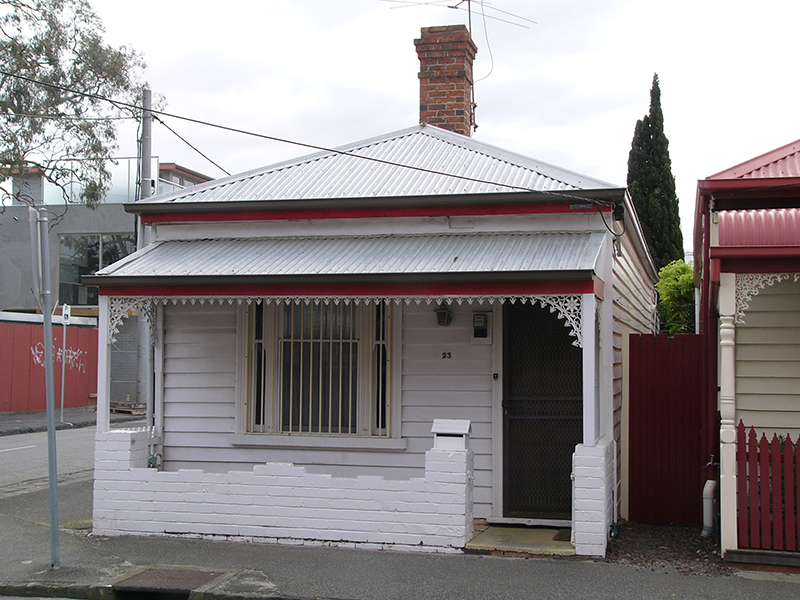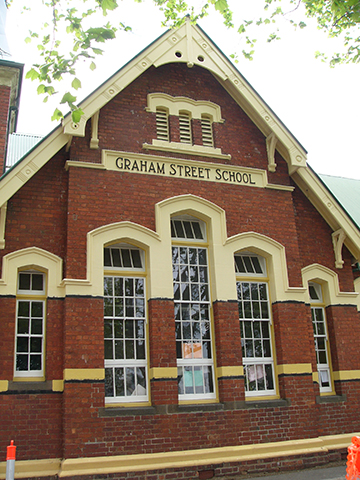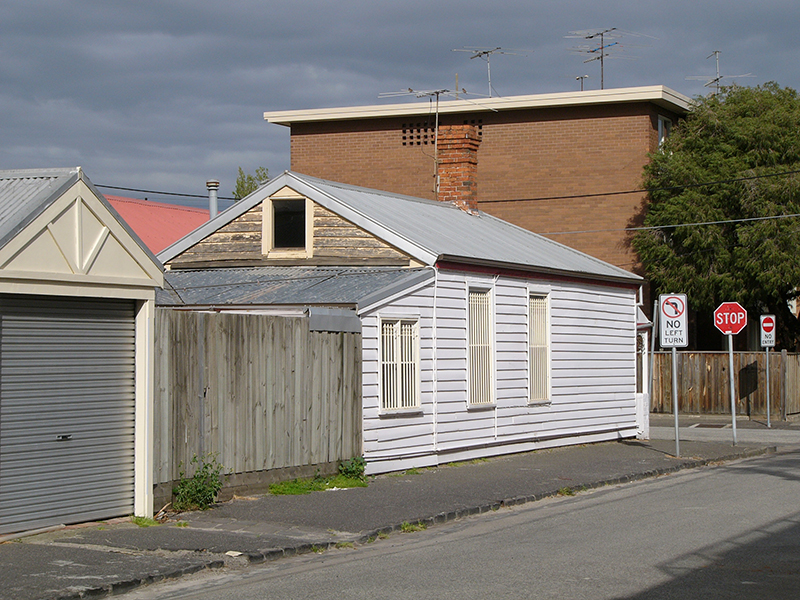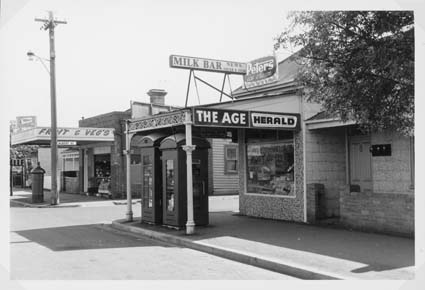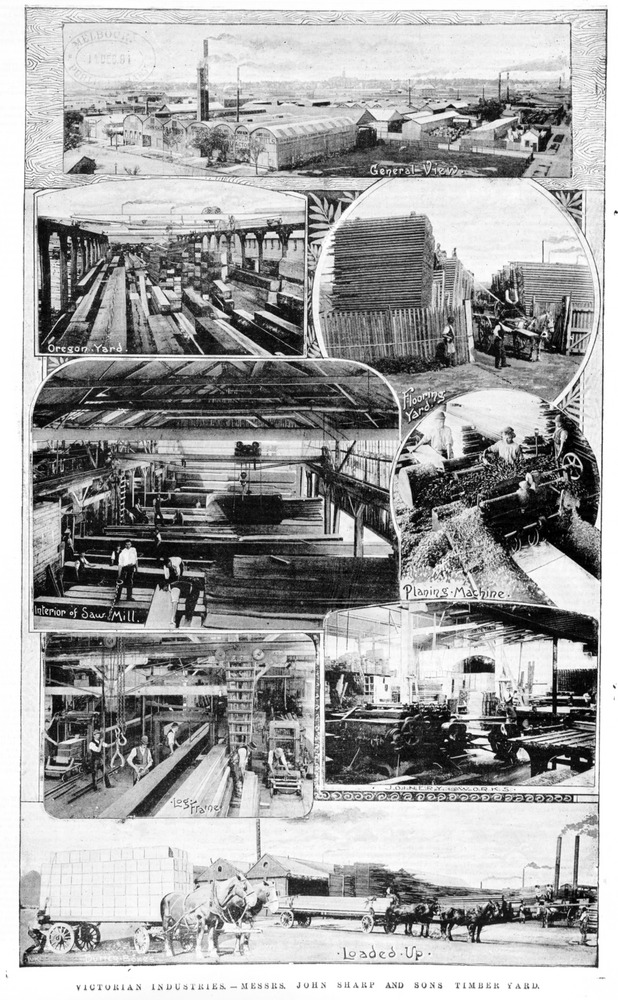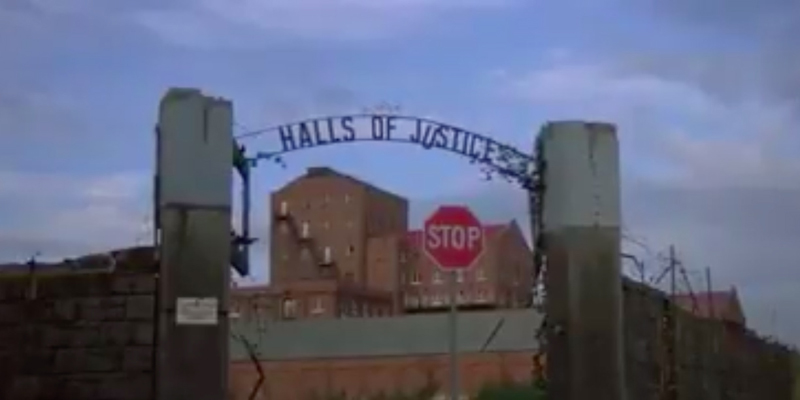‘Roar Like a Bull!’
Growing up in Port Melbourne in the middle of the 20th Century
by Albert Caton
I was born in 1942 in the maternity ward of the Women’s Hospital in North Melbourne, the son of Edward Harold (‘Ted’) Caton and Muriel Lily (Reed) Caton. Soon afterwards, my mum and I moved to Sydney where my father was stationed in the Navy during World War II. When I was just about four-years old we returned to Melbourne, living at 23 Alfred Street, Port Melbourne, where my dad’s father William Edward (‘Gramps’) Caton and dad’s mother Louisa Maria (‘Mum’) Caton had lived. We were there for about six years.
I know that I was just four-years old when I attended kindergarten in Port Melbourne. It was in the hall of the Wesleyan Methodist Church (demolished in the 1970s and replaced now by units) in Graham Street between Stokes Street and Nott Street, across the road from where my dad’s older brother Uncle Fred Caton had his butcher shop at the time. The woman who ran the kindergarten was Miss Hopkins[1]. We were seated several-to-a-small-table on very tiny chairs. It was co-ed, but tables were gender-specific. The girls’ tables were up near Miss Hopkins.
Mum and I walked the half-mile or so to the kindergarten. It was always fun at the railway crossing at Graham railway station. There were both steam-engine goods lines to the piers, and suburban electric-train lines to Port Melbourne, with two sets of large white wooden railway gates. As a youngster it was always fun to hop onto the gates and ride them as they opened or closed. They were operated by a large wheel up in the station box between the suburban and goods lines. Most of the gate-keepers turned a blind eye, but some screamed ‘bugger off’ at me from the signal-box window. It was exciting to watch from the gates when the old black steam trains were shunting; but they were coming to the end of their service days with the introduction of the large, yellow-and-blue, diesel-electric engines.
It was convenient that some of those who attended kindergarten with me were with me again in the subsequent year when I started at Graham Street State School (State School number 2932). I vaguely remember my first day. Mother in tow, I went up the steps (below the bell tower) to sit on the bench outside Mr Price’s (the headmaster’s) office.
I think I was allowed to walk to school by myself from then on because it was only a couple of blocks away from home. I had turned five in January 1947, which had made me eligible to start primary school that year. It was a pity in a way because, having no problems with progressing academically to the next grade each year, I was always the youngest (and skinniest, and weakest) in my classes.
First Grade and Grade 2, at the southern side of the school buildings, were housed together with a folding partition door/wall separating them. It was folded back for collective activities like singing. I remember the brick wall outside, below the windows—probably because on one afternoon I ran into it forehead-first and grew an egg-sized lump; god knows what they were meant to do, but butter and brown paper were applied when I reached home.
In Grade 4 we felt we had arrived. Probably because of Mrs Corbett, who smoked, and drove a sleek, mid-brown Willys sedan. Mr Lyons in Grade 5 was scary—long, lean, red-haired, wiry, and with eyes like a hawk; he ruled supreme. Well, that is until the Headmaster, Mr Price, entered the room, whereupon all would cower (perhaps even Mr Lyons). ‘ROAR LIKE A BULL!!’ he would thunder out when looking for an answer to something. Mr Lyons was scary: Mr Price was REALLY scary. Thank heavens for Mr Chambers in Grade 6 who brought sanity back to schooling. The consequence was that I finished third-top in the end-of-year-exam ranking. Lynette Jones was Dux, and perhaps Beverley McDonald was second.
Most of my play activity was with Billy and Denny Eastmuir, Ray Horsey, Gary (Wieden?) and Noel Edwards. We would occasionally tolerate Gary’s little brother Peter. One of the favourite comics at the time included the exploits of ‘The Blackhawks’—a miscellaneous assemblage of five intrepid pilots dedicated to fighting the Germans. Non-British, and hence delayed in their attempts to join the RAF, they established a squadron of their own. We would draw outlines of their planes on the Union Street bitumen and sit in them (there was virtually no vehicular traffic there), carrying out fearless missions while singing the squadron song: ‘Over land and over sea, we fight to make men free, of danger we don’t care… we’re Blackhawks!’ Biggles would have been proud of us.
Television had not arrived in Australia but we had radio; and it was always important to get inside in time to hear the evening serials: Superman (‘Up, up; and awa-a-a-y’); Captain Silver of the Sea Hawk; Hop Harrigan; Ta-a-a-r-zan, Ki-i-i-ng, of the A-a-apes; and ‘The Air Adventures of Biggles’. A few were more grown-up offerings such as ‘Mrs Obbs’; ‘Daddy and Paddy’, ‘Dad and Dave’ and ‘Life with Dexter’[2]. Even so I found their humour quite delightful. Later in the evening there were quiz shows such as Bob Dyer’s ‘Pick a Box’, Jack Davey’s Colgate–Palmolive show, and John Dease’s ‘The Quiz Kids’. I assume that our radio was rarely tuned to the ABC because we were not listeners to ‘Blue Hills’ and, unlike my wife and her sister, I was never an Argonaut.
There was a narrow laneway at the back of the block separating 23 Alfred St from the house that fronted Albert St. A small woodshed backed against the laneway fence with a covered alcove to the adjacent lavatory (also against the laneway fence for access in the past by the dunny-can man). The 3-wide bluestone blocks that lined the laneway are still apparent out to the gutter, but the property owners have closed off the laneway itself.
Post-war, dad had not returned to work as a barber. His oldest cousin Big Charlie (Watt) was a foreman on the wharves at the time, and arranged a job for dad. Each day he headed off on his push-bike with his lunch. The bike was black, with thick mudguards, huge head and tail lights and a spring-loaded dynamo that pressed against the side wall of the front tyre. There was only one gear, and it was free-wheel with a foot brake that came on when you turned the pedals backwards a little (you could also get ‘fixed-wheel’ bikes where the pedals always turned). Dad had his own cargo hook—a solid wooden bar with a fearsome metal hook coming out at a right-angle. I suppose they were good for moving wool bales around—or for self-preservation? He had a waterproof cape for rainy days. It was a Mackintosh; not an oilskin per se, but made of woven material covered with a black rubberised coating. He needed a thick scarf and balaclava for winter mornings. Even so, he always suffered badly each winter from chilblains on his ears.
At the time that we moved into Alfred Street I was fully bipedal, and so mum had requisitioned my pram as her shopping trolley. It was made of fawn-painted ply-wood with padding inside. The four wheels were spoked, with rubber around the rim. There was a cute little trap-door in the floor presumably to hold a potty. As this was during the years following the end of the war we needed ration tickets[3] for the butcher, grocer, etc. Meals were usually ‘meat-and-three-veggies’ (usually peas, carrots and potato), possibly facilitated by having Uncle Fred Caton as a butcher uncle. I remember mum’s grilled lamb chops (always delicious); fried crumbed lamb cutlets (often a bit dry, and fatty because the crumbs prevented the fat from browning); thin pork sausages in gravy; corned beef now and then; rabbit casserole sometimes (good, especially the kidneys); and occasionally tripe. Despite several attempts by mum and dad to make me eat tripe I could never stomach it (well, actually that’s not correct; I couldn’t even oesophagus it). We never had chicken because it wasn’t as readily available as nowadays. On the weekend we sometimes had lamb roast.
On Fridays we had fish and chips. There was a fish shop a block or two away at the Ross Street and Farrell Street corner, and we’d walk around to it. The options were flake (gummy shark) or (barra) ’couta (Chiko Rolls had not been invented). I was limited to boneless flake, whereas dad was sufficiently adult to cope with the bones of ’couta. The battered fish came plump and hot out of the oil, the chips crisp but moist. They were placed on a sheet of greaseproof paper then wrapped in several layers of newspaper. Newspapers were a great invention because they kept fish-and-chips piping hot for a quarter-of-an-hour until we got them home.
Horse-and-cart was the order of the day for deliveries. And for pick-ups. The garbage man had a metal cart with a curved top separated into two, front and back. One of the curved covers could be slid up so that our galvanised iron garbage can could be hoisted up and emptied into it. The smell was reminiscent of school shelter sheds—over-ripe bananas, cabbage and lettuce, and dank paper. The blinkered Clydesdale hauling it had its own smell, too close for comfort when one was forced by a parent to hold one’s palm out with a bit of bread for the bristled, yellow-toothed mouth. The baker delivered bread by horse-and-cart. The van smelled warm and delicious when the back door was open. The milk-man, too, used horse transport, with large milk cans from which he would ladle out milk to our jug (always covered by a lace doily with little beads around the edge so that it was weighted down around the sides of the jug to keep flies off). I learnt early not to cry over spilt milk. Just the reverse, in fact, on the morning when, on rounding our corner, the horse took the cart too close to the telegraph pole outside my bedroom; all that milk wasted in the gutter.
I was ten in 1952 when we moved from Alfred Street to our shop at 384 Graham Street. Dad, looking to build a better future, had decided to take on a small mixed business that the owners at the time, the Sayers family, were selling. It became a seven-days-a-week job for him and my mother (and for that matter to a fair extent for me also).
It was exciting to live in a ‘mixed business’—in reality, a just-about-everything shop; groceries, newspapers, magazines (comics!), post office, milk-bar and lollies. But also bread. Fresh bread. Every morning. Can you imagine having one room of your house set aside to disseminate the aroma of un-wrapped loaves of fresh bread? They say that when you are trying to sell a house you should brew coffee or bake bread in the oven when potential buyers come to do an inspection. Ours would have had estate agents in ecstasy. Every morning, about 150 warm, aromatic, freshly-baked loaves. Darkened high-top tins; golden slit-crusted Vienna loaves; Vienna tins; corrugated ‘pipe’ loaves; and 5-inch x 5-inch sandwich loaves. Even the sandwich loaves were nice to be near.
I oozed smug contentment living in a shop. I delighted in the freshness, aroma and real-tea flavour produced by tea leaves packed loose in tinfoil (no overtones of infused blotter and tea dust); of the warm, sweet richness of the aromas emanating from the recently-baked and freshly-opened 5-lb tins of ‘Swallow and Ariell’ biscuits (and the luxury of first access to the fresh broken ones); of the combination of smells of spices, herbs, hessian, bulk sugar and cardboard in the store-cum-weighing-up bread room.
The sweets on offer for youngsters were not pre-packaged in hygienic cellophane packs but came in bulk in cardboard boxes, and were displayed behind glass, loose, to be counted out (two-, four- or eight-per-penny) to order into small white paper bags. There were liquorice ‘straps’ and sticks; square liquorice blocks; ‘ripe raspberries’ (raspberry-coloured and flavoured gums made in tiny moulds that were raspberry-patterned); small aniseed balls; large rainbow balls (about an inch [2.5cm] in diameter, and layered in multiple colours that appeared progressively as the ball dissolved); ‘conversation’ lollies (with their messages of love and such); mint leaves; small chocolate-covered liquorice bullets (eight per penny); chocolate-covered caramel cobbers; chocolate-covered honeycomb clinkers; chocolate frogs; and musk sticks. Larger items included dark-chocolate-covered MacRobertson’s vanilla nougat bars, MacRobertson’s ‘OK’ peanut-toffee bars and Hoadley’s Violet Crumble honeycomb bars. Foot-long Jersey-toffee sticks came already wrapped and boxed.
Ice cream—Sennits vanilla, strawberry or chocolate (‘When it’s Sennits then it’s good’)—came in 5-gallon cylindrical drums, was scooped out (always dip the scoop in clean water first so that the ice cream doesn’t stick in it) individually, and was served on wafer cones (conical, of course; but there were cute little squat square ones in which one served flavoured ice blocks before the advent of icy-poles[4]). Ice creams were available as one-penny cones (for one- to four-year olds) or three-penny cones (for adults five-years and older). Up-market customers had the option of buying their ice cream pre-packed in cute little waxed-paper cups (‘dixies’, with their own tiny flat wooden spoon), or as slices wrapped in greaseproof paper and eaten between two thin rectangular wafers. Curiously, the creamy film that remained on the paper always tasted the best, if somewhat awkward to lick while holding the wafer at the same time.
We also stocked a range of Melbourne soft-drink brands at the time. Everything came in bottles; there were no cans of soft drinks, just as there were no cans of beer. We sold Marchants (the only brand that had a composition screw plug that wound into the threaded glass of the neck of the bottle—every other brand came with a crown-seal closure); Ecks (which were later taken over by Tarax); Boon Spa (Creamy Soda, Sarsaparilla and such); and, later, Cottee’s (‘Passiona’). We stocked small bottles of Schweppes mixers, but not the large, return-for-refill soda siphons that have become a collectors’ item (I suppose, for that matter, that the other bottles are also collectable now). Dad topped up the shop refrigerator to chill the bottles for sale. Its solid metal doors (no glass) opened into the space behind the counter, and customers’ requirements were supplied from there. All would be well until the temperature dropped too low (the same cabinet housed the frozen ice creams), which occasionally caused bottles to freeze and break, leaving broken glass and sticky residue inside—a bugger of a cleaning job, that didn’t help dad’s temper.
Our range of groceries and household goods was reasonable. Sugar, salt, flour and biscuits, as I’ve mentioned; butter; Kellogs corn flakes and rice bubbles, Weet-bix and Weeties (with Willie the wheat grain carrying a box of Weeties on which a smaller Willie held a Weeties box, and so on ad infinitum); tomato sauce; baked beans; Tom Piper Beef Steak and Vegetables, and Camp Pie (a.k.a. ‘Spam’ elsewhere); Davis gelatine; junket tablets (were they Hansens? In a glass tube with cork stopper?); Robur and Bushells teas; condensed milk; and so on. Then products such as Nugget shoe polish; Rinso and Persil laundry powders; Velvet, Solvol and Palmolive soaps; Sand soap (for cleaning non-stainless knives) and steel wool (it always rusted after the first use); and methylated spirits and kerosene. We had a range of semi-medical items, like Laxettes, Bex Powders and tablets (‘have a cup of tea, a Bex, and a good lie down’), Vincents APC (aspirin, phenacetin and caffeine, I believe), Bonningtons Irish Moss cough syrup (‘with pectoral oxymel of carrageen’), and Vicks vaporub.
Despite the array of offerings there were some things that our shop was not allowed to stock and sell. Items such as Ipana toothpaste (with its eye-catching, red-and-yellow-striped tube), Lifebuoy soap (pink; and oddly smelly), and Aktavite (a powdered drink something like, but undoubtedly superior to, Milo or Ovaltine) were specialty comestibles available only from Chemist shops that catered to the elite. My Aunty May, who maintained a certain elegance, made sure that such up-market products were regularly present in her shopping bag.
Aunty May and Uncle Fred Caton lived at 95 Ross Street, their place backing onto the other side of Alfred Street from our place about half-a-dozen doors away across Union Street. Uncle Fred tended to be a bit serious and sit working on his book-keeping at his kitchen table. Actually his apparent seriousness might simply have been a reflection of the fact that he was fairly deaf. Aunty May, on the other hand, was very sociable. I didn’t see much of their son my cousin Bill Caton because, being older, he was out and about socially. He frequented the YMCA, and played (Banjo?) in a jazz group there. He had a fine collection of 78s[5] featuring all the contemporary jazz greats. My favourite was Graham Bell’s ‘Smokey Mokes’.
Christmas Eve or Night was usually celebrated by a family gathering at 95 Ross Street. In some years the party would be on New Year’s Eve, our mob moving out into the street to join everybody at midnight. The parties were musical affairs with a couple of ukuleles, spoons to tap out a rhythm, and a sing-along. There was a piano in the main part of the house (because Uncle Fred had trained for a time—formal lessons much to Aunty Sadie’s disgust because she was probably the more promising prospect) but it was never called into service because the parties were never in there. Aunty Lou and Aunty Alma would always be cajoled into singing a duet of ‘Lindy, sweet as the sugar cane’[6], replete with gestures; and ‘big Uncle Charlie’ (young Charlie Watt’s father), after a (drowned-out) speech, would give his rendition of ‘Champagne Charlie’[7]. On occasional weekends there were also family gatherings at Tecoma (past Ferntree Gully) at Uncle Tom’s (Jackson’s) ‘Cabin’ there, the family travelling by suburban train via Melbourne to Ferntree Gully, and then boarding ‘Puffing Billy’, the old steam train that stopped at Upwey and Tecoma on the way to Belgrave and beyond. The cabin was a couple of hundred yards behind Tecoma station, down at right angles to the track.
But life wasn’t all play. I got my first job (well, a paid one as distinct from the slave labour I did in our shop in Graham Street, and the occasional profit from collecting and returning empty soft-drink bottles at the football for the deposit refund) when I was about eleven or twelve as an after-school paper boy[8]. I was collected at the front of the shop and trucked with other lads to Fishermen’s Bend where I sold papers to workers as they clocked out around 4 pm at DAP—the Department of Aircraft Production. Coincidentally, my mum had worked there at the start of the War when the factory was involved in the manufacture of Beaufort bombers. Later I sold papers at other Fishermen’s Bend factories—the CAC (Commonwealth Aircraft Corporation); the Aeronautical Laboratories; and General Motors Holden. The Herald—the Melbourne evening newspaper—cost three-pence (2½ cents). When sales were finished we were collected and trucked back to the Graham Newsagency in Bay Street (run by the nice Mr Bottomley and the grumpy Mr Curtin; they were also the source of papers for mum’s and dad’s shop).
I can’t remember the details now—perhaps I had an argument with Mr Curtin—but I left their employ and joined up with the other newsagent further along Bay Street (I forget their name now; but they were along Bay Street before Crockford Street broke off from it and went along to the now-demolished Hoyts picture theatre[9]). They gave me a job selling papers on the Bay and Liardet streets corner. ‘Billiard Hall’, the pitch was called. Perhaps there had been a billiards den there once; or it might still have been upstairs. I was too busy to look, because I had to try to canvass passers-by and people alighting at the bus stop across the street.
I made the mistake one day of getting onto one of the buses[10] and trying for sales on board. Quite innovative; but the bus went along Bay Street into the Bottomley/Curtin precinct, where my presence on their turf caused something of a furore. The outcome was that Bottomley/Curtin forgave me, re-employed me, and offered me a post selling papers at the London Hotel on the waterfront along the street from the Port Melbourne railway station. The young bloke who usually covered it had had to go away or have an operation or something, and would not be back for six months. I covered the front and lounge bars of the hotel; Gadsen’s tin manufacturing factory[11] across the street; and the milk bar café half-way to the station. Everything was going fine until the brewery strike. That fortnight was a series of seriously black days (and low sales).
The one salvation was the woman in the milk-bar café. When I introduced myself she told me she never gave her paper boy tips. However, at Christmas she would give them ten shillings ($1). I felt rather sorry that the young bloke I was replacing would not be back until well into the New Year. But as the days went along I began to look forward to that ten shillings. Perhaps it was because the shop window displayed a (dusty, tired, aged, but immensely impressive) collection of items of fishing gear. Skeins of solid twine; solid (6- and 8-ounce) pyramid sinkers, boxes of fearsome (about size 8/0) tinned limerick hooks—everything an eager but dumb novice angler would need. And so it was Christmas. The ten shillings never left the shop; but I did, replete with the wherewithal to pillage and plunder the local ocean (I suppose unbeknown to me it was the day that my life’s work was born—my career for 42 years became that of a fisheries biologist, from 1962 until my retirement in 2004).
To supplement my earnings from selling and delivering newspapers I was able to get a job selling streamers when overseas passenger liners were departing. The café milk-bar just outside the Customs gate at Station Pier hired youngsters for the streamer trade. We sold them at 6-pence (5 cents) each, keeping a penny of that as our wage.
The best sales were made on evenings when the boats were sailing to the UK. These were the Strath-line boats [Strathmore, Stratheden, Strathnaider], and the P&O fleet of Orontes, Orion, Orcades and Orsova. The departures were quite moving (emotionally; and of course literally). People would usually buy six to twelve streamers, passengers taking some aboard, and shore friends and family keeping some ashore. When both lots were settled, they would throw their streamers to each other, holding them and letting out more ribbon as the tugs gradually moved the ship away from the pier, until the last contact was torn. Best sales were to those who thought streamers should be thrown by unwinding a strip from the outside of the roll and then hurling the roll. That simply succeeded in breaking the roll off so that it usually fell into the water between the ship and pier. Doyens of the practice (those from families wealthy enough to have regular international travellers in their midst) knew that one pulled out and held the strip from the inside of the roll such that, when thrown, the paper streamer would coil out unbroken. We were outwardly sympathetic servicing the second round of sales to the uninitiated.
In 1958, after seven years in the Graham Street shop, Ted and Lil sold it and moved to a small self-service grocery store in Malvern Road in Tooronga, three shops around the corner from Parslow Street where my grandmother lived. And so my twelve years growing up in Port Melbourne came to an end.
[This is a condensed version of Albert Caton’s memories of growing up in Port Melbourne in the middle of the 20th Century. You can download the full version here]
[1] The Port Melbourne Historical and Preservation Society Inc. 2011 ‘Historic Port Melbourne’ Calendar noted that Miss Hopkins ran the Graham Street Wesleyan Methodist Kindergarten for some seventy years.
[2] The National Film and Sound Archive in Canberra has examples of them among its collections.
[3] Rationing, introduced from May 1942, was enforced by the use of coupons and was limited to clothing, tea (½lb/5 weeks), sugar (2lb/fortnight), butter (1lb/fortnight), and meat. From time to time, eggs and milk were also rationed under a system of priority for vulnerable groups during periods of shortage.
[4] What did kids do for craft projects before the invention of those flat sticks that were frozen in icy poles as handles?
[5] Gramophone records that ran at 78 revs per minute—the precursor of the 45-rpm and 33-rpm discs.
[6] ‘Lindy, Lindy, sweet as the sugar cane.
Lindy, Lindy, say you’ll be mine.
When the moon is a-shining, and my heart is a-pining,
Meet me pretty Lindy by the watermelon vine.’
[7] ‘Champagne Charlie is me name, and Champagne drinking is me game.
I’ll drink everything with fizz, fizz, fizz; it’s the only drink there is, is, is.
All round town it is the same; by pop, pop, pop I rose to fame.
I’m the idol of the barmaids, Champagne Charlie is me name.’
[8] When I came home with my first pay, I felt a bit like Bilbo and his ‘precious’. This disappointed my father badly. He had assumed that I’d have immediately handed my pay packet to my mother. He took me out into the yard to lecture me about it, pointing out that he and his siblings had always done that in recognition of the hardship his mother and father faced in bringing up a family. It brought home the difference between his young life during the depression and mine in favoured circumstances in a shop.
[9] The theatre’s advertising jingle (thanks to cousin Heather Wale’s recollection) was: ‘Oh we can’t show all the pictures so we only show the best; the others get the rest (you can put it to the test). So, ring your girlfriend right away, when she hears the news she’ll shout ‘Hooray!; let’s hurry along to our Hoyts suburban theatre’. No art deco building exists there now; the theatre has been demolished for construction of a boring 7 Eleven petrol station. Rather sad.
[10] Wonderful old ‘MMTB’ (Melbourne and Metropolitan Tramways Board) green things with a hot-diesel smell. As one stepped aboard and approached the driver one had to avoid the large, noisy, silver dome over the gear box or whatever that graced the floor. Some were double-deckers, complete with pole to grab to haul oneself aboard the rear platform.
[11] It was fascinating. In the absence of such a thing as OH&S I was free to wander along the Gadsen conveyor line watching how 4-gallon kerosene tins were cut, folded, turned up for the base to be soldered in place, turned upside down again for the top to be soldered on, moved along for the handle to be soldered on, and finally treated with a screw-thread filling-hole and cap.

